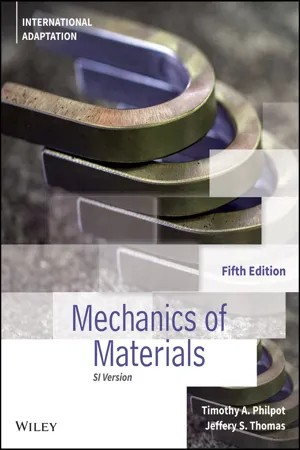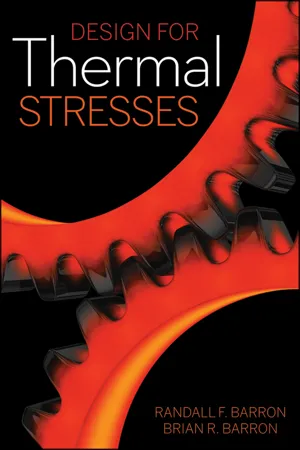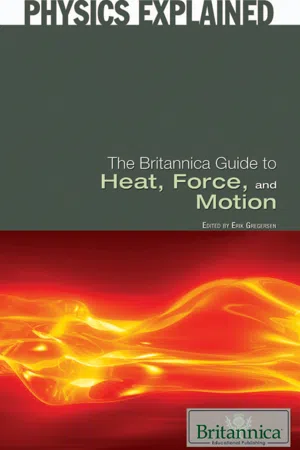Technology & Engineering
Strain Transformation Equations
Strain transformation equations are used to analyze how strain changes when an object is subjected to different loading conditions. These equations allow engineers to understand how strain components in different directions relate to each other, which is crucial for designing and analyzing structures and materials under various types of stress. By using these equations, engineers can predict and manage the behavior of materials and structures more effectively.
Written by Perlego with AI-assistance
Related key terms
Related key terms
1 of 4
Related key terms
1 of 3
7 Key excerpts on "Strain Transformation Equations"
- eBook - ePub
- StephenW. Tsai(Author)
- 2018(Publication Date)
- Routledge(Publisher)
Figure 2.2 , the components of stress and strain will change following prescribed patterns. This variation is called the transformation equation of stress and strain. The state of stress or strain remains the same, independent of the coordinate system, but the magnitude of its components change.In conventional materials, physical properties do not change with reference coordinates. This class of materials is isotropic. The transformation of stress or strain has no special meaning or utility with the exception of two special orientations; viz., the principal axes where the shear component vanishes, and the maximum shear orientation which is 45 degrees away from the principal axes. These special orientations are useful for conventional materials because a number of failure theories can be applied using the maximum principal stresses or the maximum shear stresses.In composite materials, we need to know the transformation equations of stress and strain for a number of reasons.First, the properties of composites are not isotropic. The state of stress or strain existing relative to the on-axis configuration is important in determining the stiffness and strength of composite materials. We can then use the transformation equations, for example, to find the on-axis stress from the applied stress in an off-axis orientation or vice versa.Secondly, transformation equations are needed to determine the principal stresses or strains. The same transformation equations also define the invariants of stress and strain. The concepts of principal axes and invariants are fundamental for the understanding of composite materials. The same concepts can be extended to those for stiffness and strength. They will be explained later.Finally, transformation equations for stress and strain, together with the on-axis stress-strain relations of Chapter 1 , can be used to determine the off-axis compliance and modulus of unidirectional composites. The sequence of operations is illustrated in Figure 2.3 - eBook - ePub
- James H. Allen(Author)
- 2011(Publication Date)
- For Dummies(Publisher)
Extending Stress Transformations to Plane Strain ConditionsIn this chapter, I show you how to perform the basic strain transformations by using both equations and the graphical Mohr’s circle, both of which are similar to the tools I use with stresses in Chapters 6 and 7. I conclude the chapter by showing you how to use strain gauges to measure the strains at a point in an object. After you master strain transformations, you’re then ready for a wide array of application problems.The Strain Transformation Equations — like the stress transformation equations in Chapter 7 — are derived based on simple equilibrium equations and aren’t affected by the material properties of the object. In fact, the relationships between stresses in two transformed states are almost identical to the relationships between strains.Using the stress transformation equations, you can make the following substitutions to create the Strain Transformation Equations:Normal strain ε xx for any normal stress σ xxNormal strain ε yy for any normal stress σ yyHalf of the in-plane shear strain ( γ xy /2), for the in-plane shear stress τ xyJust as with stress transformations, strain transformations become very important when you start to analyze materials with imperfections or fibers oriented at specific angles (such as with wood products or along welded seams).Transforming strainsIn this section, I show you how to perform the strain transformation calculations by using the transformation equations and then introduce you to a modified form of Mohr’s circle for plane stress that you can apply to plane strain conditions.Figure 13-1 illustrates the strain deformation of an element, and from these figures you can derive the basic Strain Transformation Equations. In Figure 13-1a, you see the effects of a normal strain in thex -direction, or ε xx . Figure 13-1b shows the effects of normal strain in the y -direction, or ε yy . And Figure 13-1c displays the effects of the shear strain in the XY plane, or γ xy .You can illustrate the orientation of a shear strain on a plane strain element in multiple ways, as I show in Chapter 12. For the examples of this chapter, I lump all shear strain into a single value reference from the vertical axis. - eBook - ePub
- Timothy A. Philpot, Jeffery S. Thomas(Authors)
- 2022(Publication Date)
- Wiley(Publisher)
13Strain Transformations
13.1 INTRODUCTION
The discussion of strain presented in Chapter 2 was useful in introducing the concept of strain as a measure of deformation. However, it was adequate only for one-directional loading. In many practical situations involving the design of structural or machine components, the configurations and loadings are such that strains occur in two or three directions simultaneously.The complete state of strain at an arbitrary point in a body under load can be determined by considering the deformation associated with a small volume of material surrounding the point. For convenience, the volume, termed a strain element , is assumed to have the shape of a block. In the undeformed state, the faces of the strain element are oriented perpendicular to the x, y, and z reference axes, as shown in. Since the element is very small, deformations are assumed to be uniform. This assumption means thatFigure 13.1aFIGURE 13.1- planes that initially are parallel to each other will remain parallel after deformation, and
- lines that are straight before deformation will remain straight after deformation, as shown in .Figure 13.1b
The final size of the deformed element is determined by the lengths of the three edges dx′, dy′, and dz′. The distorted shape of the element is determined by the angles θ′xy, θ′yz, and θ′zxbetween faces.The Cartesian components of strain at the point can be expressed in terms of the deformations by using the definitions of normal and shear strain presented in Section 2.2 - Josip Brnic(Author)
- 2018(Publication Date)
- Wiley(Publisher)
Equation (3.20) ). The above implies that the tensor components are symmetric with respect to the main diagonal of the tensor. There are fifteen unknowns in total. This means that one needs to have fifteen equations if the unknowns need to be derived. However, the theory of stress and the theory of strain are derived “in general”. This means that the theories have been derived independent of the material properties; that is, independent of the material from which the considered body is made. As such, the theory of stress is based on the equilibrium of forces while the theory of deformation is based on the compatibility of geometry. It is to be expected that the stress occurring in a body is associated with the deformation and the material properties. The question that arises is what the relationship between stress and strain is. It is very difficult to find universal equations that can be used to summarise the relationship between stress and strain for all of types of solid bodies, and especially if all of types of continuum are considered. If solid bodies are being considered, tests indicate that stress depends on strain, strain rate, temperature, time and other factors, and this fact can be expressed in the form:(7.1)In Equation (7.1) , εijrepresents strain; represents the strain rate; T represents temperature; t represents time; pi represents the material parameters. Equations of this type are known as constitutive equations. In many cases, for example in metallic materials, but also many others, Equation (7.1) may be written as:(7.2)If the problem involves the temperature, then the temperature distribution needs to be known or it needs to be solved for using the equation of heat transfer. However, compatibility conditions need to be fulfilled.Solid bodies, with regard to their responses, are usually divided into the following categories:- Elastic bodies
- Plastic bodies
- Viscoelastic bodies
- Viscoplastic bodies.
- Isotropic bodies
- Orthotropic bodies
- Anisotropic bodies.
In Section 5.1 some material responses were shown. Sometimes, relationships represented by Equations (7.1) and (7.2)- eBook - ePub
- Randall F. Barron, Brian R. Barron(Authors)
- 2011(Publication Date)
- Wiley(Publisher)
In the discussion of the stress–strain relationships and temperature field equations in this chapter, we will consider only materials that may be considered homogeneous (the same material throughout) and isotropic (properties the same in all directions). For design purposes, many engineering materials may be treated as homogeneous and isotropic with little error. Materials such as wood, layered composites, and reinforced concrete are exceptions to this statement.5.2 Strain RelationshipsThe relationships between the displacement of parts of a material and the resulting strain on the material depend only on the geometry or coordinate system used. The forces causing the strain do not enter into the strain expressions, and no material properties appear. Let us look first at the definitions of strain, and then consider the relationships involving the strain components.5.2.1 Strain ComponentsLet us consider the element in Cartesian coordinates shown in Figure 5.1 . Let us denote the components of the displacement of a particular point (x, y, z ) as u (x -displacement), v (y -displacement), and w (z -displacement). In general, the displacement of a point a small distance from the point in question will be somewhat different.Figure 5.1. Differential element used to determine the strains in Cartesian coordinates.The extensional strain may be defined as the change in length per unit original length. For example, the extensional strain in the x -direction is5.1Similarly, the extensional strains in the other two directions may be found from the following relations:5.25.3The shear strains or distortion strains are defined as the change in the angle between two intersecting planes of the element. Because the strains are small, the tangent of the angle is practically equal to the angle itself. It may be observed that tan ϕ = ϕ, with less than 1 percent error, when ϕ ≤ 0.17 rad = 10°. The shearing strain between the edge of the element in the x -direction and the side of the element in the y - eBook - ePub
- Britannica Educational Publishing, Erik Gregersen(Authors)
- 2010(Publication Date)
- Britannica Educational Publishing(Publisher)
ij by using the tensor transformation law and properties noted for the orthogonal transformation matrix.Principal stresses . Copyright Encyclopædia Britannica; rendering for this edition by Rosen Educational ServicesVery often, in both nature and technology, there is interest in structural elements in forms that might be identified as strings, wires, rods, bars, beams, or columns, or as membranes, plates, or shells. These are usually idealized as, respectively, one- or two-dimensional continua. One possible approach is then to develop the consequences of the linear and angular momentum principles entirely within that idealization, working in terms of net axial and shear forces and bending and twisting torques at each point along a one-dimensional continuum, or in terms of forces and torques per unit length of surface in a two-dimensional continuum.STRAIN
The shape of a solid or structure changes with time during a deformation process. To characterize deformation, or strain, a certain reference configuration is adopted and called undeformed. Often, that reference configuration is chosen as an unstressed state, but such is neither necessary nor always convenient. If time is measured from zero at a moment when the body exists in that reference configuration, then the upper case X may be used to denote the position vectors of material points when t = 0. At some other time t , a material point that was at X will have moved to some spatial position x . The deformation is thus described as the mapping x = x (X , t), with x = x (X , 0) = X . The displacement vector u is then u = x (X , t) - X ; also, υ =∂x(X , t)/∂t and a = ∂ 2 x (X , t)/∂t 2 - eBook - ePub
Electrical and Electronic Devices, Circuits, and Materials
Technological Challenges and Solutions
- Suman Lata Tripathi, Parvej Ahmad Alvi, Umashankar Subramaniam, Suman Lata Tripathi, Parvej Ahmad Alvi, Umashankar Subramaniam(Authors)
- 2021(Publication Date)
- Wiley-Scrivener(Publisher)
In Section 1.4, various experimental results on strain engineering are shown and compared with theoretical and simulated data. In the last few decades, various scientists have explored strain engineered FET devices through several experiments and these results indicate that by using this performance enhancement technique, several challenges of unstrained nano-scale transistors can be overcome. Although there are not many laboratories to fabricate these modern FETs, many published reports are available to validate the theoretically and simulated predictions in this field of strain engineering. Some of these experimental data are discussed in brief to get some idea on real-time fabrication output. Finally, in Section 1.5, a summary of this chapter is discussed in brief and some possible future research problems in this area are included. 1.2 Theory of Strain Technology 1.2.1 Stress and Strain Strain: The result of applying force which slightly deform/misalign the atomic structure of a material. Stress: It is the result of strain in any material. Therefore, it can be said that by applying some external force, if the atomic arrangements of a material can be altered slightly, then interatomic force will change, and as a result, the material will be called stressed/strained material. Now, let us consider a point P having radius vector r and position vector (x, y, z) under stable condition. When an external force is applied, the point P shifted slightly at P’ and the new radius vector becomes r’ and new position vector becomes (x’, y’, z’). The displacement is given by [3]; (1.1) and this displacement gives the measure of deformation of the material under strain quantitatively
Index pages curate the most relevant extracts from our library of academic textbooks. They’ve been created using an in-house natural language model (NLM), each adding context and meaning to key research topics.
Explore more topic indexes
Explore more topic indexes
1 of 6
Explore more topic indexes
1 of 4






